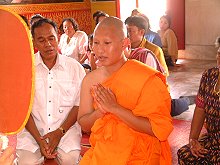Preface to “A Lexicon Resource for the Learned”
The Qualities of a Translator
In general, the precious scriptures of the Triumphant Buddha are constructive in the beginning, middle, and end and are solely to act as eyes to clarify the path to liberation and omniscience for those who take interest in being freed. As that is the case, eye-opening translators as well need to think over and again (about this fact), only cherishing the teachings of the Able One with the thought, “How wonderful it would be if these very methods were to remain long in the world.” In other words, they need to rid themselves of a biased mind that wishes for profit or fame, and analyze, with an honest mind, the particulars of the words and their meanings.
Regarding their analysis, when they themselves do not know (the meaning), they need to ask thoroughly learned scholars, regardless of them being of greater or lesser fame (than they themselves are). Having eliminated their doubts in this way, they need then to translate with clear and easily understandable words that do not contradict the meaning. If (translators work in this fashion), they will be able to bring about a vast increase of excellent build-ups (of positive force) on the mental continuums of themselves and others. Because of that, they will be doing service to the teachings of the Triumphant Ones and will obtain immeasurable stocks of positive force.
But, on the other hand, even though they themselves are not learned, some translators are arrogant with the puffed-up pride of being learned. Even though others are learned, the eye of intelligence of these translators is veiled with anger from a mind that is biased against such (learned ones). Holding the pure Dharma to be of little importance, they are happy with translating as many volumes as they can in order to gain the wealth of a daily salary. If (translators work in such a fashion), then as a result of sullying the stainless enlightening words of the Buddha with the dirty waters of their wrong and faulty explanations, they will have unbearable sufferings beyond what themselves or anyone could imagine.
How to Translate
When translating a text, if it is easy to understand following the Tibetan word order and the Mongolian meaning does not get confused or garbled, then translate the text like that. In cases in which it is not like that, violate the original word order and make the meaning clear. For things to be easily expressible when they are in verse, one can violate the word order within a shloka (a Sanskrit verse) so as to make it clear. And when extravagant (filler) words have been added for the sake of the meter, whether it is one, two, or three words, see what the meaning of the whole is and, violating the original literal text, translate clearly. But it is important not to confuse the logical order of the meanings.
Also, one must choose terms that preserve the connotations of the original terms. Some Tibetan terms, if translated literally, would become many words in Mongolian, and the meaning would get obscured. For the many examples like this, it is all right to discard the extra words, so long as it doesn’t affect the meaning. Sometimes, if one doesn’t add a few extra words, the full connotation does not come across. In those cases, translate by adding extra words to help make the meaning clear and not to have it be just dead language.
If one term has several meanings, choose terms that decisively cover its various (individual) occurrences. When it is possible to conclude that a term has just one meaning, translate it as such. When one can’t conclude that it has just one meaning, if one can find a Mongolian word with both meanings, use it wherever the Tibetan term occurs.
If one were to translate names of people such as pandits, mahasiddhas, kings, and ministers, and names of places, flowers, and fruit trees, it would be difficult to understand and would be ungraceful language. For situations in which, even if such names could be translated roughly, it would be uncertain if the meaning will or will not be as it should, add the word Pandit or King or flower, and so on, before or after the name, and leave the name in Sanskrit or Tibetan.
For commentaries to great texts, if its root text has already been translated, then translate the words of the root text in the commentary in accordance with it. If it has not been translated, then first translate the root text; and for this, translate it in agreement with the commentaries.
For debate terms used by the defender and the attacker in a debate, choose terms that fit the thought of the two and keep the flow of the debate. Translate the points for proving or disproving with words that are sharp and easy to understand.
Also, translate words of praise, abuse, wonder, depression, and fear with words that are well known to everyone in Mongolian, which have strong connotations and can move the mind, and which fit the occasion.
One must translate a text just as the author composed it, even if there are some in which the meaning of the text is not well explained, or in which it is obvious that it explains incorrectly. Don’t fix it up by adding from good explanations from other texts; because if one does like that, then the traditions of different teachers will become confused.
In texts of guideline instructions, when names of gods, substances, numbers, and so forth, are indicated by other hidden, obscuring words (gab-tshigs) (such as “fire” for “ three”), translate them as they are. Do not translate them with the bare words (that were being obscured), because that would nullify the necessity for the obscuring words.
When there are poetic synonyms in poetry, such as “beautiful throat” for “ donkey,” translate the word itself (that is, the poetic synonym) and not the word that it is referring to, because otherwise it would make it unpretty.
Even though the foundation to which two terms, such as rtsa-ba’i rnam-shes (root consciousness) and kun-gzhi (basis for all, Skt. alaya) are getting at is the same, yet there is a slight difference between the ways of ascribing the terms and explaining them in the Avatamsaka and Chittamatra traditions. Therefore (in such cases), translate them in accordance with the individual texts (in which they appear). Otherwise, if one thought that they have the same meaning, the terminology will get mixed up and conflated.
Then there are such terms as bden-par grub-pa (truly established existence; true existence) and rang-gi mtshan-nyid-kyis grub-pa (existence established by individual defining characteristic marks; inherent existence). In Prasangika, they could be translated such that one could substitute for the other, since they have the same meaning (in that system). Nevertheless, since there are many instances in which, like with Svatantrika-Madhyamaka, they cannot be made into the same meaning, because they have two very different meanings (in that system), one must examine well and translate them according to their own traditions. Also, although bdag-med (lack of an impossible “soul”; selflessness; identitylessness) and bden-med (lack of truly established existence) are exactly the same in Prasangika, yet in some lower systems of tenets, there are important differences, such as all phenomena being bdag-med, but not accepting that they are all bden-med. Therefore, one must differentiate them from each other; otherwise, since one will be taking situations in which one sees them explained as the same and applying it in all situations, then the special differences among systems of tenets will become topsy-turvy.
Further, one must pay attention to tense, case, the position in a sentence of the word only, emphasis, and differences between old and new spelling and terminology.
Even though Tibetan and Mongolian poetry have different meters, lengths of line, and so forth; nevertheless, one must translate poetry in a poetic way, with the full meaning, easy to understand, and with lines nearly of equal length. In some praises and requests, although it is not disagreeable to use (Mongolian stylistic) conventions, such as each line starting with the same word in Mongolian, yet don’t do this in great texts; otherwise, they become too wordy and the meaning gets obscured.
If it becomes necessary to coin and use a new term that is not in this lexicon and which does not appear in others, don’t just make up terms at pleasure at any place. Rather, consult monks and translate without contradicting texts or reason.
“Dag-yig mkhas-pa’i ‘byung-gnas” by Changkya Rolpay-dorjey (lCang-skya Rol-pa'i rdo-rje) translated and introduced by Alexander Berzin.



